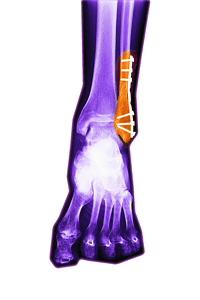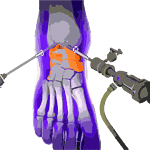Foot And Ankle Fractures

Foot and ankle fractures refer to broken bones in the foot or ankle region, which can occur due to trauma, accidents, or sports injuries. These fractures can vary in severity, from simple hairline fractures to complex fractures involving multiple bones and joint dislocations.
The treatment of foot and ankle fractures aims to promote proper healing, restore function, and alleviate pain. The approach to treatment depends on several factors, including the location and type of fracture, the extent of displacement, and the overall health of the patient.
Non-surgical treatments are often considered for stable fractures, where the bones remain in proper alignment. This may involve immobilization through the use of casts, braces, splints, or removable walking boots. These devices provide support, protect the injured area, and facilitate the healing process. Rest, elevation, and the use of pain medication may also be recommended.
In cases where the fracture is displaced or unstable, or when conservative treatments are ineffective, surgical intervention may be required. The goal of surgery is to realign and stabilize the broken bones using various techniques, such as internal fixation (using plates, screws, or rods), external fixation (using pins and frames outside the body), or in some instances, joint fusion or joint replacement.
Following surgery or immobilization, a period of rehabilitation is crucial to regain strength, mobility, and function. Physical therapy and exercises are often prescribed to promote healing, prevent stiffness, and restore range of motion. The rehabilitation process may also include gait training and gradual return to weight-bearing activities under the guidance of a healthcare professional.
The recovery time for foot and ankle fractures varies depending on the severity of the injury and the treatment approach. It may take several weeks to several months for complete healing and return to normal activities. Regular follow-up appointments with the healthcare provider are necessary to monitor the progress and make any necessary adjustments to the treatment plan.
Prompt and appropriate treatment of foot and ankle fractures is essential to minimize complications and long-term consequences. By utilizing a combination of non-surgical and surgical interventions, healthcare professionals aim to restore the stability and function of the foot and ankle, enabling individuals to resume their normal activities and regain quality of life.








